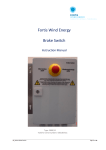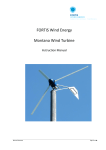Download Manual_Overvoltage_Charge_Controller_48V
Transcript
Fortis Wind Energy Overvoltage / Charge Controller 48V-100A Instruction Manual Type: IN 48V_100A ___________________________________________________________________________________________________________________ IM_Overvoltage Controller_48V-100A Page 1 of 11 No part of this document may be reproduced or transmitted in any form or by any means, electronic or mechanical, including photocopying and recording, for any purpose without the express written permission of FORTIS WIND ENERGY. FORTIS WIND ENERGY reserves the right to make changes to any and all parts of the documentation, at any time, without obligation to notify any person or entity of such changes. © Copyright 2008, FORTIS all rights reserved. Fortis Wind Energy 9751 AC Haren The Netherlands ___________________________________________________________________________________________________________________ IM_Overvoltage Controller_48V-100A Page 2 of 11 § Table of Contents § Index: Page 1 Introduction____________________________________________________________ 4 1.1 Health and Safety Information_____________________________________________ 4 2 3 4 4.1 5 6 7 8 Safety precautions_______________________________________________________ 5 Overview of functions____________________________________________________ 5 Installations____________________________________________________________ 6 Programming of the charging end voltage of the battery_________________________ 7 Operation and maintenance_______________________________________________ 8 Specification___________________________________________________________ 9 Scope of delivery________________________________________________________ 9 Wiring Diagram__________________________________________________________ 10 ___________________________________________________________________________________________________________________ IM_Overvoltage Controller_48V-100A Page 3 of 11 1. Introduction Thank you for choosing FORTIS energy systems. Your choice means tried and tested reliability, no maintenance costs and the convenience of a quiet, independent power supply. FORTIS wind turbines are in operation all over the world and can withstand almost every environment imaginable. Even Arctic expeditions have benefited from the reliable power the FORTIS wind turbine produces. FORTIS tests their systems under the worst possible weather conditions. FORTIS turbines should only be installed by trained and approved installers. A FORTIS-system is almost always composed of various components: the wind turbine itself is only one component of this system. We can supply controllers for battery charging and for grid connection. For hybrid systems, controllers are available to couple a photovoltaic solar generator or to a diesel or petrol generator together to a FORTIS Wind turbine. In other words, the possibilities with an FORTIS wind turbine are endless in the sense that they can be adapted to suit almost every conceivable application. 1.1 Health and Safety Information Please refer installation and servicing to qualified service personnel only. High currents and forces are produced by this wind turbine system and incorrect installation or use may result in • risk of electric shock or fire • mechanical damage • injury or death Health and Safety means having a positive and caring attitude and this should be foremost in your mind in everything you do. The prevention of accidents, injury and damage is a top priority. Health and Safety work is not a matter to be left to someone else to deal with. Everyone has a duty to other colleagues, the public and customers. Important security notice This Instruction Manual contains important operational guidelines and security considerations that require your attention. Before installation, it is essential that the user first studies this user's manual in detail and keeps in mind the safety matters that need attention. During user installation and operation one must refer to this handbook's documentation. If you are unfamiliar with installation as shown below, DO NOT CONTINUE and let a qualified Technical Engineer proceed with correct installation. Failure to comply with the guidelines and instructions will void your warranty. Electric risk symbol This electric risk symbol is a sign of High Voltage. ___________________________________________________________________________________________________________________ IM_Overvoltage Controller_48V-100A Page 4 of 11 2. Safety precautions Please read this manual prior starting with the installation or commissioning. This charge controller can only be used for the FORTIS-Montana wind turbine with the 48V generator and 5 kW rated power. The system for safe operation comprises of: 1] this charge controller 2] 4 pieces ballast resistor (1865W @ 56V each) that are delivered with the charge controller properly connected (in parallel) 3] the 48V battery 4] the FORTIS-Montana wind turbine Under no circumstances operate the wind turbine without charge controller or without connected ballast resistors. Wrongly dimensioned cables, improper connections, etc. bear a high risk of sparks and fire, injuries, or damage of the wind turbine! Please read this manual and the installation and operation manual of the wind turbine before starting the installation. Do not short circuit the “+” and “-“ or “R1” and “R2” terminals. For connection to the “R1” and “R2” terminals only use the ballast resistors delivered with the wind turbine. The internal capacitors may be charged, never short circuit the capacitor or ballast resistor “R1” and “R2” terminals External fuses for the battery are required, please use 125 A types suitable for DC current 3. Overview of functions The charge controller has two main functions: 1] Rectifying the generator voltage for direct battery charging 2] Control of the external ballast resistors in case the battery is near its charging end voltage. This controller puts additional load on the wind turbine to prevent overcharging of the battery. The two functional units are internally decoupled via separate rectifiers and do not interfere with each other. The controller electronics incl. the display are supplied from the battery terminals, please do not short circuit these terminals to make sure that the controller can work properly. The ballast resistors are PWM controlled. If the voltage at the DC-output is below the programmed value, there will be no load supplied to the ballast resistors. Above that voltage the power is supplied to the ballast resistors. The controller and the display are active whenever the voltage at the battery terminals is above 20V. ___________________________________________________________________________________________________________________ IM_Overvoltage Controller_48V-100A Page 5 of 11 The display shows the rectified generator voltage, charging current, the rotor speed (rpm) and the power supplied to the ballast resistor as a percentage of its rated power. 4. Installation The charge controller is designed for wall mounting only. Screws and dowels are supplied with the controller. Please use all 4 screws. For sufficient cooling the outside air temperature has to stay below 35°C and the controller is not exposed to direct sunlight. The casing is suitable for outdoor-installation (IP44). Only use the original ballast resistors of the following rating supplied with the wind turbine: 1985W @ 56V (4 resistors connected in parallel) The minimum cable cross section for each resistor is 4 mm². Shielded cables are recommended for sensitive environments, the shielding shall be connected to the ground terminal next to the ballast terminals. The rated current is 100 A, please use appropriate cables with a minimum of 2 x 10 mm² or 1 x 25 mm² cross section for each conductor for the battery connection and a minimum of 16 mm² for the generator connection. ___________________________________________________________________________________________________________________ IM_Overvoltage Controller_48V-100A Page 6 of 11 Connect the metal casing to ground, 2 free “PE” terminals are available Connect the 4 ballast resistors in parallel and the cases and cable shielding to the “Ballast” terminals “R1” (gray), R2” (gray), and “PE” (green/yellow) Connect the battery to the terminals “+” (gray), “-“ (blue) Connect the 3 phases of the generator to the terminals “L1” (gray), “L2” (gray), “L3” (gray) 4.1 Programming of the charging end voltage of the battery Ensure that the charge controller is not connected to any power source and that the internal capacitors have self discharged. Inside the DIN-rail housing with the display there is a DIP-switch which allows programming the maximum charging voltage for the battery. Remove the 2 small cross-drive screws and carefully open the upper part of the case with the display. The charging-end voltage of the battery can be programmed according to the battery type used: ___________________________________________________________________________________________________________________ IM_Overvoltage Controller_48V-100A Page 7 of 11 DIP-switch 1: OFF 2: OFF 1: OFF 2: ON 1: ON 2: OFF 1: ON 2: ON Charging-end voltage (default) 55.2 V 56.4 V 57.6 V 58.8 V 5. Operation and maintenance Inside the cabinet is a main switch for braking the generator via direct short circuit of all three phases. The switch is not for active control of the wind turbine but only for maintenance of the electrical system comprising of ballast resistors and battery. If maintenance or works inside of the charge controller have to be made, please follow the procedure below: 1] Stop the wind turbine as described in its operation manual, secure it against self restarting 2] Open the cover 3] Move the lever of the internal “brake” switch to the position “ON” which means that the brake will be activated. 4] Use a clamp current meter suitable for DC current to ensure that no current flows to the battery 5] Disconnect the cables of the charge controller at the battery side or switch off the external battery circuit breaker 6] Wait for 15 minutes until the internal capacitors are discharged 7] Measure the voltage at the capacitors to ensure that the remaining voltage is low enough to start working on the inside of the controller box. After finishing the work inside of the charge controller, switch off the “brake” switch, close the cover and restart the wind turbine. ___________________________________________________________________________________________________________________ IM_Overvoltage Controller_48V-100A Page 8 of 11 6. Specification Electrical Minimum active supply voltage from the battery Maximum supply voltage Current consumption from battery Rated battery voltage Rated DC current Rated generator power Switch-in voltage for ballast resistor DIP switch 00 DIP switch 01 DIP switch 10 DIP switch 11 Internal protection Mechanical Dimensions (width x height x depth) Weight Operating temperature range 20 65 approx. 15 48 100 5000 (2.30 V/cell) 55.2 (2.35 V/cell) 56.4 (2.40 V/cell) 57.6 (2.45 V/cell) 58.8 IP44 V V mA V A W V V V V 360 x 340 x 210 15.0 -10 ... +40 mm³ kg °C Valid for: Serial numbers 0111008... 7. Scope of delivery The controller This manual 4 screws and 4 dowels 6 mm Key for the cabinet ___________________________________________________________________________________________________________________ IM_Overvoltage Controller_48V-100A Page 9 of 11 8. Wiring Diagram ___________________________________________________________________________________________________________________ IM_Overvoltage Controller_48V-100A Page 10 of 11 ___________________________________________________________________________________________________________________ IM_Overvoltage Controller_48V-100A Page 11 of 11



















